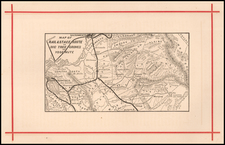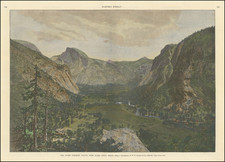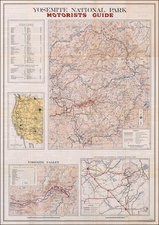Mammoth Plate Photograph by Watkins
Cathedral Spires, Yosemite - A favorite of Ralph Waldo Emerson's
"Carleton E. Watkins was a giant of photography. He is arguably America's greatest landscape photographer" - Palmquist & Kailbourn
An original mammoth-plate photograph of Cathedral Spires by Carleton Watkins, the outstanding 19th century photographer of the American West.
In 1861 Watkins began making his famous large-scale "mammoth-plate" photographs in California's Yosemite Valley -- iconic views that are now unanimously accepted as some of the most beautiful photographic images ever made in the West. These images were influential in persuading the United States Congress to pass pioneering legislation to preserve the Yosemite Valley, which bill, the Yosemite Valley Grant Act, was signed into law by Abraham Lincoln on June 30, 1864. This law granted Yosemite Valley and the Mariposa Grove to the State of California, "to be held for public use, resort, and recreation...[the use of which in this manner] shall be inalienable for all time." Watkins was consulted by Yosemite Commissioner Frederick Law Olmsted on the best means to preserve Yosemite as a public trust. It wasn't until 1890, through the efforts of John Muir and others, that Yosemite was signed into existence as the nation's third National Park.
While the technical and aesthetic qualities of Watkins's Yosemite photographs were early lauded by enthusiasts and experts alike, including William H. Brewer of the California State Geological Survey ("the finest I have seen"), J. D. Whitney (who named a 8,500-foot peak in Yosemite after Watkins), Edward L. Wilson (editor of the Philadelphia Photographer, who noted that "[Watkins's] camera is mightier than the sword") and Oliver Wendell Holmes (the foremost photography critic of the time who said Watkins's photographs reached "a perfection of art which compares with the finest European work"), it wasn't until the 1970s that Watkins was re-discovered by the photographic art world, thus shining a brighter light on his life and work. Watkins's mammoth-plate views of Yosemite are now solidly ensconced as part of the canon of fine art photography. Examples of Watkins's Yosemite photographs are in many great institutional collections, including those in the Bancroft Library, the Getty, the Metropolitan Museum of Art, the Huntington Library, and numerous other institutions.
According to Weston Naef, the present image was made by Watkins, ca. 1865-1866. The photographer made a similar view from a slightly different perspective ca. 1878-1881. Watkins often returned to the same locations in Yosemite, making numerous photographs of the same subject over time.
According to Watkins's biographer Tyler Green, a version of Watkins's Cathedral Spires was hung in the White House, possibly in commemoration of Lincoln's signing of the Yosemite Act into law in 1864. That print, along with several other Watkins Yosemite views were apparently pilfered by Andrew Johnson at the end of his presidency, and taken to his Greeneville, Tennessee home, where they still reside.
Also fond of this Watkins view. Ralph Waldo Emerson displayed a version of the present photograph of Cathedral Spires in the sitting room of his Concord, Massachuetts home, pairing the print with one of Watkins's views of Mt. Shasta:
Emerson hung two huge Watkinses of Mount Shasta and Yosemite. Emerson, who, in his own writing, had repeatedly urged artists toward metaphor, seems to have known that Watkins's pictures said something about him... Next to the Shasta picture, Emerson hung Cathedral Spires, a picture that presents a mountain feature named for an architectural embodiment of the church, and in which the church has been replaced by nature and landscape...The Watkinses are still there today. - Tyler Green, Carleton Watkins: Making the West American.
At some point Watkins began assigning his own catalogue numbers to his Yosemite photographs, with the present view conforming to CEW 22.
Mammoth-plate Camera.
Watkins made the negative for this image using his custom made oversized camera. This camera was constructed by a local San Francisco instrument maker to handle negatives as large as 18 x 22 inches (the so-called mammoth-plate format).
Watkins's most famous visit to Yosemite Valley took place in the summer of 1861, when the photographer brought with him for the first time a special camera designed to accomodate sheets of glass 45.7 x 55.9 cm (18 x 22 inches) in size that were popularly called "mammoth plates." Exactly how Watkins procured this highly unusual oversize camera is uncertain. One possibility is that it was fabricated by someone such as Thomas Tennant, who advertised his services in Hutchings's magazine as an instrument maker on Battery Street in San Francisco. - Naef & Hult-Lewis, page 45.
Watkins's Autograph
According to Weston Naef and Michael Hargraves, the style and character of Watkins' handwriting evolved over time. Specifically, the way he formed the W in his name changed from having pointed bottoms to having curved bottoms. This change, which happened sometime in 1861 (or possibly as late as 1863), was accompanied by additional modifications to his signature marked by spaces where he lifted the pen from the writing surface at mid stroke. Oddly enough, by 1872 Watkins had reverted to the pointed-bottom W.
An aid to dating the photograph at hand. Naef and Hargraves state there are few prints with Watkins's autograph signature made between about 1865 and 1875. This is because he was too busy in the field, carting around his mammoth-plate camera up and down the Pacific Coast, to be able to sign many prints.
The present photograph bears an autograph signature that conforms in every detail to Watkins's pre-1872 handwriting, i.e. it has a curved-bottom W, with instances where he has lifted the pen from the writing surface causing a space interruption in the line. The signature here matches one described in Naef's catalogue as having been made by Watkins ca. 1865-1866, and, given the unlikelihood of a 1865-1875 signed print, evidence points to 1865 as the date of the present print.
Rarity
Original signed mammoth plate Yosemite prints by Watkins from this early period (ca. 1865) are rare in the market.
Versions of this image are held in many important photographic collections, suggesting it has enjoyed significant popularity among collectors over the years: Bancroft Library, the J. Paul Getty Museum, Metropolitan Museum of Art, Boston Public Library, Crocker Art Museum, Cooper-Hewitt, the California State Library, the Huntington Library, and others.
Carleton Watkins (American, 1829-1916) was one of the most highly acclaimed of early western photographers, yet Watkins's work has never been fully cataloged. No complete listings of his "Old Series" stereoviews, published before 1875, are known.
Watkins extensively photographed early San Francisco, Yosemite, Mendocino and the Sierra Nevada mining regions. His photogaphs of Yosemite helped influence Congress and President Lincoln in the preservation of Yosemite Valley. Watkins also made some of the earliest photographs of Southern California and the Pacific Nortwest. Watkins' Pacific Railroad series documents construction of the trans-continental railroad from Sacramento to Utah.











![(Mammoth Plate Photograph) [El Capitan, Yosemite]](https://storage.googleapis.com/raremaps/img/small/88268.jpg)

![(Mammoth Plate Photograph) Cathedral Rock - Yo semite [Cathedral Rock, Yosemite]](https://storage.googleapis.com/raremaps/img/small/88251.jpg)

![Map Showing the Summer Resorts on the Pacific Coast, adjacent to the lines of the Central and Southern Railroads. [California Tourist. Yosemite, The Big-Tree Groves Geysers, Monterey and other Popular Summer Resorts of Californa]](https://storage.googleapis.com/raremaps/img/small/41461.jpg)
